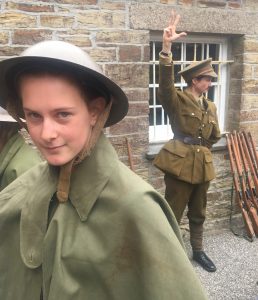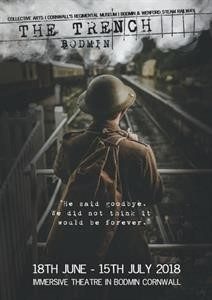
The Trench experience was a unique mixture of acting and audience participation, involving costumes, trains and trenches. It was an incredible opportunity for a tiny peek-in at what life would have been like for the soldiers of World War One. Designed for ages 12 and over, this experience included “gas” (dry ice), “bombs” (sound effects) and “blood” (paint), all designed to draw a more thorough picture of what the trenches were like for the soldiers.
The journey started off with all new recruits (the audience) enlisting in groups of six, forming platoons. Each new soldier was given a metal helmet, trench cloak and dog tag. The dog tags each carried a different name, and that was your character for the day. I was Thomas Rendle, a stretcher carrier. Fragile participants in the Trench need to beware, for on this journey voices were to be raised at you. It is a wonder that after so many shows the actors still had the ability to speak!
After some witty officer banter, soldiers were sent marching in unison down to the steam railway station to meet their train. Songs were sung and jokes shared throughout the carriages as the way was made ‘across the border to France’. When arrived, a frenzied run up to the trench was needed to make it past the enemies sniping from the trees. A cup of ridiculously sweet tea was offered to each soldier and they were told to sit and wait for the next orders. Between dialogues, loud bangs of bombs were heard and shrapnel was catapulted over the walls of the trench, causing everyone to cower and cringe.
Part way through the day, letters were handed out and everyone was encouraged to share theirs with the rest of the platoon. It ranged from mothers writing, to wives, to children. In my opinion, this was really good because it allowed us to feel for the people left behind at home, and how they had to survive without their men. Following this, the soldiers had to write a letter in return but this was interrupted by a captured German angrily being dragged into the trench. Soldiers also learnt how thieves were treated as someone was caught trying to steal other people’s belongings.
As the war went on, tension tightened and fear escalated as soldiers (the actors) were sent over the top of the trench only to return covered in “blood” (paint). Messages occasionally turned up on a strip of yellowing paper often carrying confusing orders and more soldiers were sent into the fray.
Excitement for the new recruits rose when everyone prepared to go over the top of the trench. However, just when the countdown reached two, an important message was passed to the leading officer. This message told everyone that the war would end on the 11th of November 1918 at eleven o’clock. Now, only the train journey back home remained.
What I thought was really good was that, after the performance we took time to look at all the names of the soldiers who died during the war, they were listed outside of the trench. This allowed us to see if our character survived or not, and to appreciate how many died for us. Also, a one-minute silence was held which I believe was very respectful. The whole experience was carefully judged so that it was amusing and light-hearted at times, but also respectful and sombre.

